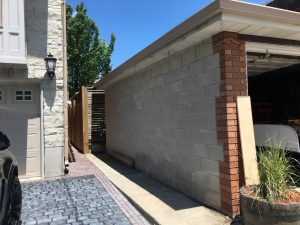
I want some greenery on the west side of my garage. It has concrete there, and I wonder if we can cut the concrete in two places, maybe 2 feet square, and grow euonymus or ivy that will eventually climb up the wall. There is 6 hours of sunlight there, as there is another driveway to the west. What should I do once the concrete is cut. Or should I buy a big container. I thought in the soil would be better. And would I have to dig out the likely clayish soil out, replace with black soil, before planting? I want to make sure this is feasible before I get the concrete cut.
Thank you for contacting the Toronto Master Gardeners with your inquiry.
Before you decide what to plant near a concrete wall, consider the long-term effects your choice may have. Selecting the wrong plants can cause damage to the wall or the plants, depending on the situation. The general rule of thumb for planting any shrub near the foundations of a house is from 3 to 5 feet away, depending on the mature size of the plant. This will avoid not only potential root damage, but will also accommodate the width of a fully-grown shrub.
Another problem to consider is that the area in contact with the building’s foundation is usually the driest spot in your entire yard. Whatever you decide to plant will find itself in the rain shadow caused by the eaves above, and this means very little precipitation reaches the ground. Also, the foundation gives off heat, drying out the soil at the base of the wall even further. In addition, the average foundation is made of concrete, a very alkaline product that leaches into the adjacent soil.
Two vines which would cover the wall relatively quickly are Virginia Creeper and Boston Ivy. Virginia Creeper (Parthenocissus quinquefolia); is a fast-growing native vine that is very attractive, especially in the Fall when the foliage changes to a deep red. However, it is not evergreen and will drop its leaves during the winter; nevertheless, the vine would adhere to the stone/brick wall and leaf out again in the spring. It produces small black ornamental berries which is a source of food for some birds.
The second option Boston ivy (Parthenocissus tricuspidata) which is very similar to the Virginia Creeper has a vigorous growth habit (at least 10 ft. per year). It is deciduous as well, will become dark red in the fall and produce small berries that will provide a source of food for winter birds.
For more information, please see the following.
If you do decide to build a raised bed there is one important factor to keep in mind and that is drainage. Make sure to drill a few drainage holes into the bottom of the containers. You also need to make sure that the container drains away from the foundation. We have several archived posts on container gardening. Simply type”container” in the search bar located on the right side of the page. Insulating Plant Containers on a Balcony gives lots of useful information.

